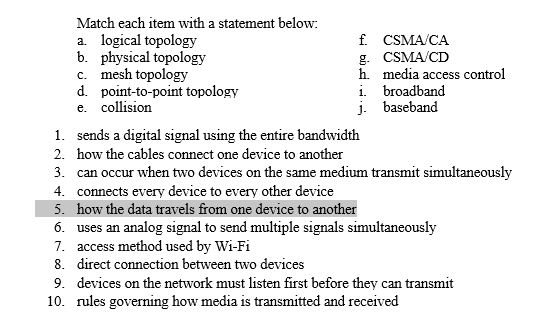A) the length or type of cabling, the transmission speed, and the type of transmissions
B) the transmission speed, the type of transmissions, and the length or type of cabling
C) the transmission speed, the length or type of cabling, and the type of transmissions
D) the length or type of cabling, the type of transmissions, and the transmission speed
Correct Answer

verified
Correct Answer
verified
Essay
MATCHING
Match each item with a statement below:

Correct Answer

verified
Correct Answer
verified
True/False
A collision can occur on a switch only if the switch is operating in full-duplex mode.
Correct Answer

verified
Correct Answer
verified
Multiple Choice
What type of logical topology is at work when using an Ethernet hub?
A) logical bus
B) logical ring
C) switched topology
D) hierarchical topology
Correct Answer

verified
Correct Answer
verified
Essay
What are the advantages and disadvantages of a physical star topology?
Correct Answer

verified
A physical star is the easiest topology ...View Answer
Show Answer
Correct Answer
verified
View Answer
Essay
What is the difference between a network's physical topology and its logical topology?
Correct Answer

verified
the physical topology of a network refer...View Answer
Show Answer
Correct Answer
verified
View Answer
Essay
Describe the structure of an Ethernet frame.
Correct Answer

verified
An Ethernet frame is composed of three p...View Answer
Show Answer
Correct Answer
verified
View Answer
Multiple Choice
What is the Ethernet frame type that is used by TCP/IP?
A) Ethernet 802.3
B) Ethernet 802.2
C) Ethernet II
D) Ethernet SNAP
Correct Answer

verified
Correct Answer
verified
Multiple Choice
What is the most common topology and technology combination in use today?
A) logical bus / Ethernet
B) logical bus / wireless LAN
C) logical ring / token ring
D) switched / Ethernet
Correct Answer

verified
Correct Answer
verified
Essay
In a physical bus topology, why do the ends of the cable have to be terminated?
Correct Answer

verified
When data is sent onto the network in a ...View Answer
Show Answer
Correct Answer
verified
View Answer
Essay
What is the difference between operating in half-duplex mode or full-duplex mode and why does it eliminate collisions?
Correct Answer

verified
When a station is operating in half-dupl...View Answer
Show Answer
Correct Answer
verified
View Answer
Essay
What is CSMA/CD and how does it work?
Correct Answer

verified
CSMA/CD is the media access method used ...View Answer
Show Answer
Correct Answer
verified
View Answer
Essay
What type of topology, both physical and logical, is implemented in a token ring network, and how does it work?
Correct Answer

verified
A token ring network uses a physical sta...View Answer
Show Answer
Correct Answer
verified
View Answer
Essay
What are the four primary physical topologies? Briefly describe each one.
Correct Answer

verified
the four most common physical topologies...View Answer
Show Answer
Correct Answer
verified
View Answer
Multiple Choice
When a wireless computer uses a peer-to-peer connection to directly connect to another wireless computer, it is operating in what mode?
A) infrastructure
B) ad hoc
C) hot spot
D) Wi-Fi
Correct Answer

verified
Correct Answer
verified
Multiple Choice
In a token ring network, what is the central device called?
A) multiport Ethernet switch
B) multiservice switch
C) multisession drive
D) multistation access unit
Correct Answer

verified
Correct Answer
verified
Multiple Choice
What is the main disadvantage of cable modem networking?
A) The modems have to modulate and demodulate the signals.
B) It is only capable of speeds up to 60MBps and usually only delivers 10MBps.
C) It uses an asymmetrical communication scheme.
D) It uses a bus topology.
Correct Answer

verified
Correct Answer
verified
Multiple Choice
In a physical bus topology, both ends of the medium must be terminated in order to prevent what?
A) signal propagation
B) signal bounce
C) signal degradation
D) collision
Correct Answer

verified
Correct Answer
verified
Multiple Choice
In wireless networks, what type of media access control is used?
A) CSMA/CD
B) CSMA/CARP
C) CSMA/CA
D) CDMA
Correct Answer

verified
Correct Answer
verified
Short Answer
When a wireless computer connects with an AP before it connects with other devices, it is operating in ____________ mode.
Correct Answer

verified
Correct Answer
verified
Showing 21 - 40 of 41
Related Exams